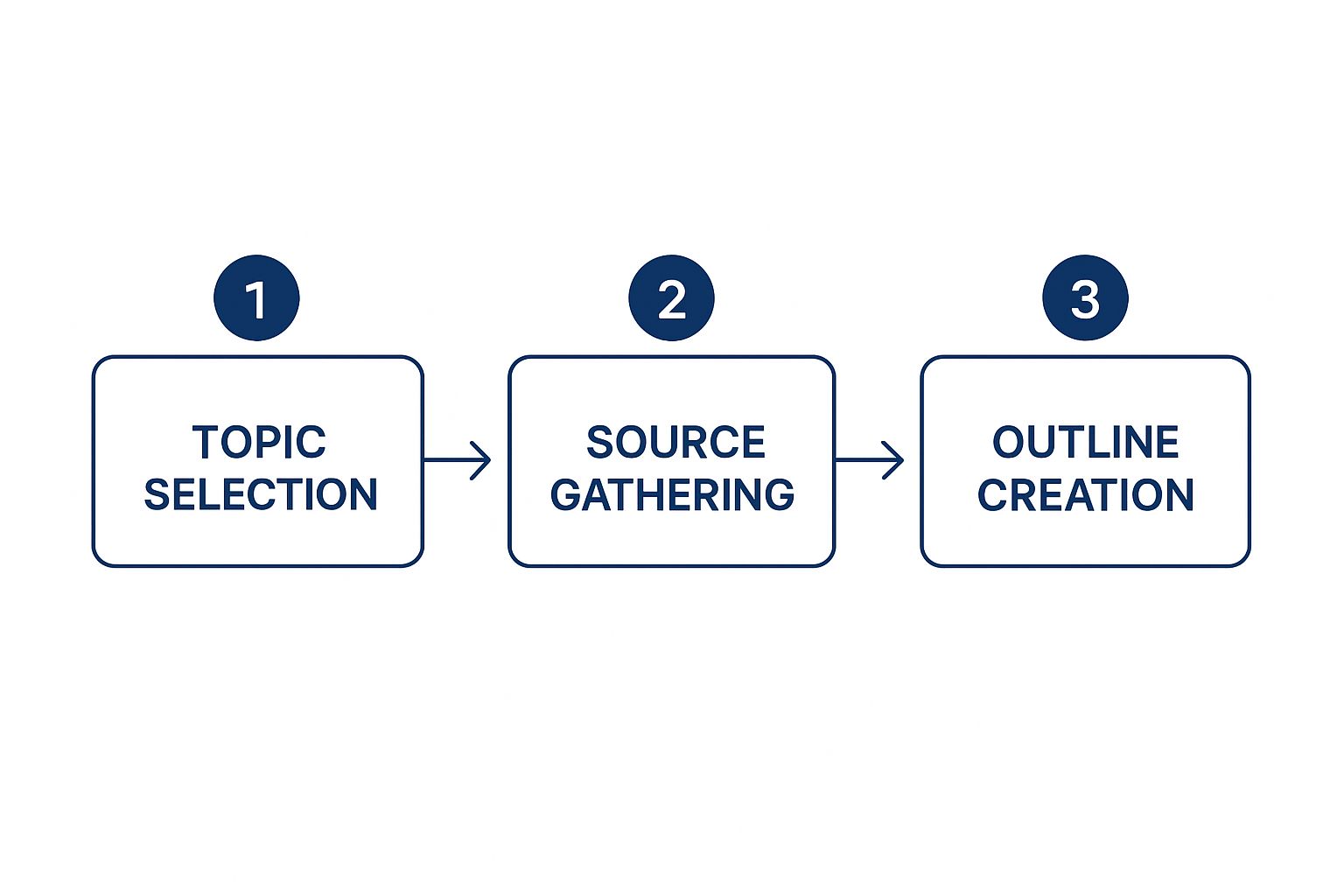Let's be honest: a messy content creation workflow is more than just a minor annoyance. It’s a silent killer of your team’s energy, creativity, and, yes, your budget. It shows up as blown deadlines, soul-crushing revision cycles, and content that just doesn't hit the mark.
Putting a structured, repeatable system in place isn't some "nice-to-have" corporate buzzword—it's the very foundation of sustainable growth and an ROI you can actually measure.
Moving Beyond Content Chaos

If your content process feels like you're constantly putting out fires, you’re in good company. The pressure to pump out more and better content is relentless. And it's not just in your head; audience expectations have skyrocketed.
Think about it: the average blog post is now over 70% longer than it was just a decade ago. This isn't just fluff—it reflects a huge shift toward deeply valuable, comprehensive resources. In this new reality, a disorganized process is a recipe for failure.
When there's no clear system, the damage spreads quickly.
- Creative Burnout: Your best writers and designers burn out navigating confusing feedback and redoing work, not on creating things that move the needle.
- Wasted Resources: Every dollar and hour spent on pointless revisions and administrative back-and-forth is a dollar not spent on strategy or promotion.
- Strategic Misalignment: It's way too easy to publish content that’s completely disconnected from your core marketing goals, leading to campaigns that fall flat.
The Hidden Costs of Disorganization
The real price of a broken workflow isn't just the visible frustration—it's the missed opportunity. Every minute someone spends hunting for the "final_final_v3.docx" or trying to decode a vague comment in a long email chain is a minute they're not engaging with your audience or analyzing what works.
It's death by a thousand paper cuts for your marketing ROI.
A chaotic workflow quietly eats away at your team's morale and your content's effectiveness. The biggest risk isn't a single failed campaign, but the slow, creeping decline in quality and enthusiasm that eventually becomes the new normal.
This is exactly why building a clean, repeatable process is no longer optional. If you're looking for a full playbook, you can find a guide on how to master your content creation workflow that breaks it down step-by-step.
By establishing a system everyone understands, you free up your team to do what they do best: create content that connects with real people and drives real business results. You turn the process from a source of stress into a serious competitive advantage.
Building Your Workflow Foundation
A solid content creation workflow is your secret weapon for delivering quality, consistently. It’s what turns the messy, often unpredictable art of content production into a smooth, manageable system. I like to think of it in four key stages: planning, creating, reviewing, and publishing.
But don't get hung up on these as rigid, sequential steps. Think of it more like a flexible framework you can tweak for your team. The real goal here is to build a rhythm that cuts out the guesswork and lets your team do what they do best: create content that actually connects with people.
The Strategic Planning Stage
Every truly great piece of content begins long before anyone starts writing or designing. This is the planning stage, and it's all about strategy. It's where you get serious about understanding who you're talking to and what they actually need from you.
This means digging into audience insights, keyword research, and what your competitors are doing, then turning all that data into a pipeline of solid ideas. When you plan properly, your content has a huge head start because it’s built on data, not just a gut feeling.
Let's say a B2B SaaS company is targeting the keyword "customer feedback tools." Their planning might look something like this:
- Analyze the SERPs: What are the top-ranking articles missing? Where are the content gaps we can fill?
- Talk to Support: What are the most common questions our own customers ask about feedback?
- Choose the Right Format: Instead of another generic listicle, maybe a detailed comparison guide would be more valuable.
This first phase is all about defining what success looks like before you even start creating. The infographic below breaks down how to move from a broad idea to a solid outline.

As you can see, a good plan flows naturally from selecting a topic, to gathering credible sources, and then structuring those ideas into an outline that makes sense.
The Content Creation Phase
With a rock-solid plan in hand, it's time to actually create the thing. This is where your ideas become real, tangible assets—a blog post, a video, a landing page. And the single most important tool in this phase? The content brief. A detailed brief is your single source of truth, killing confusion before it starts and making sure everyone is on the same page.
A great brief isn't just a suggestion; it's a guide. It should always include:
- The primary goal and target audience.
- The target keyword and a handful of related secondary keywords.
- A detailed outline, complete with H2s and H3s.
- Key messaging points and brand voice guidelines.
- A list of internal and external links to include.
This isn't just for writers, either. Designers, videographers, and anyone else involved in creation needs this clarity. It’s the difference between a smooth handoff and a week of frustrating back-and-forth emails. To get a much deeper look into perfecting this entire process, check out our guide here: https://bugsmash.io/blog/creative-workflow-mastery-field-tested-strategies/.
To give you a clearer picture of how these stages connect, here's a simple breakdown.
Key Stages of a Modern Content Workflow
This table outlines the essential phases, what happens in each, and what the main goal is.
| Workflow Stage | Core Activities | Primary Goal |
|---|---|---|
| Planning | Ideation, keyword research, competitor analysis, outlining | To define a clear strategy and success metrics for the content. |
| Creation | Writing, designing, recording, developing assets | To produce high-quality content based on the established plan and brief. |
| Review | Editing, fact-checking, stakeholder feedback, approvals | To refine the content for quality, accuracy, and brand alignment. |
| Publishing | SEO optimization, formatting, scheduling, promotion | To launch the content and ensure it reaches the target audience. |
Having these stages clearly defined helps everyone on the team understand their role and how it contributes to the final product.
The Collaborative Review Cycle
The review stage is where so many workflows completely fall apart. We've all been there—vague feedback, endless revision cycles, and nobody knowing which version is the "final_final_v3.docx." This is why a clear, structured feedback loop is non-negotiable.
Your goal is to make feedback constructive, not chaotic. This is exactly what tools like BugSmash were built for. By letting stakeholders leave precise, contextual comments directly on websites, PDFs, or images, you eliminate the soul-crushing ambiguity of "make it pop" and turn feedback into clear, actionable tasks.
The quality of your final output is directly proportional to the quality of your review process. A messy review cycle guarantees a mediocre result, no matter how brilliant the initial idea was.
Figure out who needs to review the content and in what order. A common flow might be editor → subject matter expert → legal/compliance. By setting clear deadlines for each person, you keep the project moving and prevent those dreaded bottlenecks.
The Publishing and Promotion Process
At last, you’re ready to hit "publish." But that’s not the end of the road. A truly effective workflow includes a plan for getting your content in front of eyeballs. This means doing more than just posting it to your blog and hoping for the best.
Once your system is humming, you can master your content creation workflow and dedicate more energy to the promotion that actually drives results.
I highly recommend creating a simple pre-publish checklist to make sure nothing slips through the cracks.
- Final SEO Check: Are the meta title, description, image alt-text, and internal links all good to go?
- Formatting & Readability: Is the content broken up with short paragraphs, subheadings, and visuals?
- Scheduling: Is it set to go live at an optimal time based on when your audience is most active?
After publishing, the workflow shifts to promotion. This could mean sharing it across social media, sending it out to your email list, and doing outreach to any experts or sources you mentioned. A good system ensures these vital final steps are baked into the process, not forgotten.
Fixing the Broken Review and Approval Cycle

We've all been there. The review phase—where a perfectly good content creation workflow grinds to a halt. It’s the dreaded bottleneck where creative momentum dies, killed by endless email chains, confusing spreadsheets, and feedback that’s too vague to be useful.
Who hasn't seen the infamous "make it pop" comment that offers zero direction? This cycle isn't just frustrating; it's expensive. It chews up hours of your team's time, pushes deadlines into the red, and creates friction between creators and stakeholders. All that energy that should be going into the next big idea gets drained by the constant back-and-forth.
Breaking free from this chaos means rethinking how your team gives and gets feedback.
Defining What Good Feedback Looks Like
The first step is to establish some clear rules of engagement. Vague, subjective feedback is the enemy of an efficient workflow. Your team needs a shared understanding of what constitutes helpful, actionable input. This is about moving away from gut feelings and toward specific, objective suggestions.
For example, instead of a reviewer saying, "I don't like this paragraph," they should be aiming for something more constructive. Something like, "This paragraph is a bit dense. Can we break it into two shorter ones and add a bulleted list to make the key points stand out?" Now that's feedback a writer can immediately act on.
A frictionless review process is built on clarity and precision. When feedback is specific, centralized, and tied directly to the content, revision cycles shorten from weeks to days, or even hours.
This proactive approach sets clear expectations for everyone. It encourages reviewers to think critically about their suggestions and frame them in a way that moves the content forward, not just sends it back to the drawing board.
Centralizing Communication with Visual Tools
One of the biggest culprits in a broken review cycle is scattered communication. When feedback lives in a dozen different places—emails, Slack threads, and random Google Docs comments—you're living in a version control nightmare. No one is ever sure they’re looking at the latest draft or have seen all the required changes.
This is where visual feedback tools like BugSmash make a world of difference. Instead of trying to describe a change, stakeholders can click directly on the website, PDF, or image and leave a precise, contextual comment right where it’s needed.
This simple shift has a massive impact:
- Eliminates Ambiguity: A pin dropped on a specific design element is infinitely clearer than an email trying to describe "the blue button in the top right."
- Creates a Single Source of Truth: All feedback, conversations, and resolutions live in one place, attached directly to the asset itself.
- Accelerates Revisions: Creators get a clear, consolidated to-do list of changes, which dramatically cuts down on revision time.
By adopting a more structured and tool-assisted approach, you can fix what is often the most painful part of your workflow. To see how, check out our guide on how to transform your content review process with online proofing tools.
A content creation workflow that works for a solo creator will absolutely buckle under the pressure of a five-person team. What feels efficient today can easily become a major bottleneck tomorrow. The goal isn’t to build one perfect, rigid system, but to create a flexible one that grows with you.
For the solo creator, the biggest enemies are burnout and inefficiency. The time commitment varies wildly; while some creators spend just a few hours a week, 5% invest over 40 hours weekly—basically a full-time job. You can find more details in this creator economy report on market.us.
To stay sane and productive, you need to master two core strategies: time-blocking and content batching.
Instead of trying to shepherd one blog post from start to finish, batch similar tasks together. Maybe you dedicate Monday morning to outlining four articles, spend Tuesday writing two of them, and then knock out all the graphics on Wednesday. This approach minimizes the mental whiplash of context switching and helps you build real momentum.
Scaling for a Growing Team
The moment you bring on your first team members—a writer, an editor, a designer—your scrappy, ad-hoc system is going to break. This is the time to get serious and formalize your process with a dedicated project management tool. A simple Kanban board in a tool like Trello or Asana can work wonders here.
Your new priorities are all about clarity and communication.
- Define Roles Clearly: Who owns each stage? The writer is responsible for the draft, the editor for quality and flow, and the strategist for the brief and final sign-off. No more guessing games.
- Centralize Your Calendar: Everyone needs to work from a single, shared content calendar. This becomes your command center for deadlines, publishing dates, and promotion schedules.
- Standardize Briefs: Every single piece of content should start with a consistent, detailed brief. This ensures every team member gets the same information right from the start, which drastically cuts down on rework later.
As your team gets bigger, your most valuable asset isn't some complex new tool—it's a shared understanding of how work gets done. Your workflow becomes the invisible team member that keeps everyone aligned and moving in the same direction.
Adopting ContentOps for Large Organizations
For larger organizations juggling multiple brands, regions, or product lines, the challenge shifts to maintaining consistency at a massive scale. This is where a ContentOps mindset comes in. Think of it as a strategic approach that treats your content like a core business asset, managing its entire lifecycle with precision.
You're no longer just managing a few tasks on a board; you're managing a complex operational system. The focus moves to building scalable infrastructure, like a centralized digital asset management (DAM) system to house all your brand guidelines, logos, and approved imagery.
Review cycles also get way more complicated, often roping in legal, compliance, and product teams. This is where visual feedback tools become non-negotiable for managing input across departments. For instance, annotating mobile app screenshots or complex designs requires specialized tools to keep feedback clear and actionable. If that sounds familiar, you might find our guide on the top mobile annotation tools for teams helpful.
By applying these principles as you grow, you can make sure your content creation workflow is an asset that supports your growth, not something that holds it back.
Weaving Creator Partnerships into Your Workflow

Let's be honest, an effective content strategy today is about more than just what your team creates in-house. Bringing creators and influencers into the mix is a powerful way to tap into new, highly engaged audiences. But if you don't have a plan, these partnerships can quickly throw a wrench in your team’s well-oiled content creation workflow.
The trick isn’t to reinvent the wheel. It's about adapting your existing system. You need a dedicated, parallel process for collaborators that mirrors your internal one but has a few key adjustments. Start by finding partners who genuinely connect with your brand's values—not just the ones with the biggest follower counts.
The results speak for themselves. Investment in the creator marketing space has exploded, growing by 143% in the four years leading up to 2025. It's easy to see why when 70% of brands say their highest ROI campaigns involved creators. To see more of what’s coming, you can learn more about 2025 creator marketing statistics.
Adjusting Your Workflow for Creators
Bringing external talent into your process requires a few smart tweaks. Think of it as adding a guest lane to your content highway—it needs clear signs and rules of the road to keep everything moving without a traffic jam.
A great place to start is with a specialized co-branded brief. This document should look familiar to your internal team but be built specifically for a creator.
- Clear Objectives: Lay out the campaign goal and key messages, but be sure to leave them enough room to use their unique creative voice.
- Asset Management Plan: Get specific about how and where they’ll submit drafts and final content. A shared folder or a DAM is perfect for this.
- Mandatory Elements: List any required calls-to-action, tags, or disclosure language (like #ad or #sponsored) right up front. This avoids painful, last-minute edits.
Getting this clarity from the get-go prevents the kind of friction that so often comes from mismatched expectations.
The goal of a creator workflow isn't to micromanage their creativity. It's to provide a clear framework that empowers them to do their best work while staying aligned with your brand’s strategic goals.
Managing a Separate Review Cycle
Finally, you’ll want to set up a separate—but connected—review process. A creator’s content can easily get lost or delayed if it’s thrown into the same internal feedback loop with your legal and compliance teams. The better approach is to dedicate one point person on your team to manage their specific review cycle.
This is where a visual feedback tool like BugSmash becomes a total game-changer. Creators can upload their draft video or image, and your team can drop precise, time-stamped comments directly onto the file. No more confusing email chains or vague feedback. Everything is consolidated, actionable, and easy to track, which keeps the collaboration on schedule and your partnership strong.
Common Workflow Questions Answered
Even with a killer plan, a few questions always pop up once you start putting a new content creation workflow into practice. It’s completely normal. Let's walk through some of the most common hurdles I've seen teams face so you can navigate them with confidence.
One of the first things people ask is, "Okay, but which software is the best?" Honestly, there's no single magic bullet. The best tool is the one your team will actually stick with. Don't get seduced by a complex, enterprise-level behemoth if a simple Kanban board in Trello or Asana gets the job done. My advice? Start simple.
Where you shouldn't skimp, however, is on the review and approval process. This is where specialized tools are a non-negotiable. Trying to manage feedback in a chaotic email thread is a recipe for disaster. A dedicated visual feedback platform creates a single source of truth for all comments, keeping everyone on the same page.
How Do I Get My Team On Board?
Getting team buy-in can feel like a bigger challenge than building the workflow itself. You can't just hand down a new process from on high and expect everyone to instantly love it. The secret is to involve them from the very beginning.
Sit down with your team and ask them about their biggest headaches with the current process (or lack thereof). What's wasting their time? What creates the most confusion?
Then, you can frame the new workflow as the solution to their specific problems—less time chasing down feedback, clearer expectations from the start, and ultimately, more time to do the creative work they enjoy.
True adoption happens when your team sees the workflow not as a set of rules imposed upon them, but as a tool that genuinely makes their jobs easier and more rewarding.
When you're ready to launch, don't go for a big-bang rollout. Start with a pilot program, maybe with one or two small, receptive projects. Their success stories will become your most powerful internal case study, making it much easier to convince the rest of the team.
Should Our Workflow Be The Same For All Content Types?
That’s a great question, and the answer is almost always no. While the core stages—planning, creation, review, publishing—will likely be consistent, the nitty-gritty tasks within each stage absolutely should change based on the content. The process for a quick social media update should be way leaner than what’s required for a deep-dive research report or a polished video.
Think of your main workflow as your master template. From there, you can create lighter, adapted versions for different formats.
- For a Blog Post: Your process might involve a detailed creative brief, a couple of writing and editing rounds, a thorough SEO check, and a final review from a subject matter expert.
- For a Tweet: This could be as simple as a quick draft and a peer review in a dedicated Slack channel right before it goes live.
The goal is to match the rigor of the process to the complexity of the content. This ensures you're staying efficient on smaller tasks without ever sacrificing quality on your most important assets.
Ready to fix the most painful part of your content workflow? BugSmash eliminates confusing feedback cycles by allowing your team to leave precise, visual comments directly on websites, videos, and PDFs. Get clear, actionable feedback in one place. Try it free at bugsmash.io.




